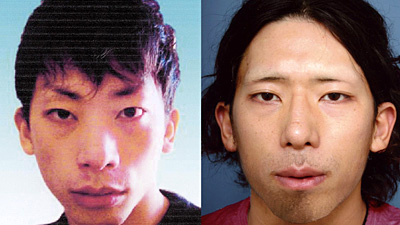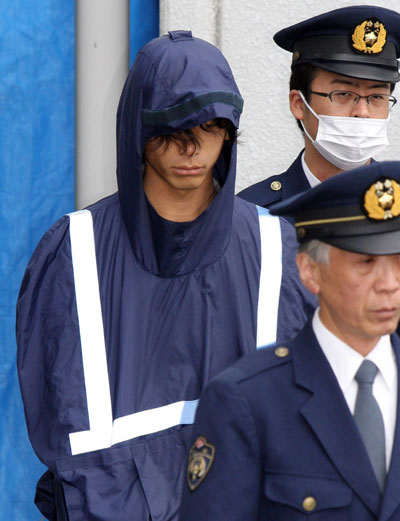Police turn to Internet, TV to catch fugitives
Updated: 2012-08-15 08:57
By Zhou Wa (China Daily)
|
||||||||
To catch criminals, police worldwide are using social networks, psychological tactics and TV programs.
Facebook scans private chatting sessions and posts to catch users who violate its terms of use or seek criminal activities, according to Reuters.
The world's largest social networking site immediately calls law-enforcement agencies after it finds and flags users who use its accounts for potential criminal activities, said Jeffrey Duncan, special agent supervisor for the Florida Department of Law Enforcement, in an interview with Reuters.
|
 |
| Tatsuya Ichihashi's face (left) before he altered it to evade capture, and his face after the alterations (right) Provided to China Daily |
"A man in his early 30s was chatting about sex with a 13-year-old south Florida girl and planned to meet her after middle-school classes the next day," he said.
"Facebook's extensive but little-discussed technology for scanning postings and chats for criminal activity automatically flagged the conversation for employees, who read it and quickly called police. Officers took control of the teenager's computer and arrested the man the next day."
As long as information goes out on the Internet, "pressing the 'Delete' button cannot remove the information completely," Tang Lan, an expert on information security from the China Institutes of Contemporary International Relations, told China Daily.
Four out of five police officers said they use social media platforms to help them with their investigations, according to a survey recently published by LexisNexis Risk Solutions.
Social media is becoming a popular tool in law enforcement, especially in departments serving smaller cities, the survey said.
Meanwhile, UK police also set traps for suspects using attractive windfalls as bait.
In one case, undercover Derbyshire police officers sent letters to dozens of people who had evaded arrest asking them to call a marketing company to collect a free crate of beer, a report in The Telegraph said.
The fugitives were told that they needed to arrange a date and time for the free alcohol to be dropped off at a certain address.
 |
|
Tatsuya Ichihashi, who raped and killed the British teacher Lindsay Ann Hawker in 2007, arrives at the Gyotoku police station in Ichikawa city in suburban Tokyo in November 2009. Jiji Press |
But instead of getting free beer, the wanted men found themselves confronted by police, handcuffed and under arrest.
A total 19 suspects fell for the hoax and called the number on the letter, which put them through to police officers.
Alleged offenses committed by some of those arrested include burglary, robbery and sexual assault, according to The Telegraph.
Chief Inspector Graham McLaughlin, who is leading the project known as Operation Rocky, told The Telegraph: "These suspects are people who have managed to evade arrest for some time, so we have used different tactics to find them.
"It has been very cost-effective as it can take a lot of time and money to track people down. We will continue to use new tactics when necessary."
Besides challenging psychological capability of the fugitives, police in the UK, the US, Germany and many other countries also use TV shows, which reconstruct the crime scenes, to find criminals.
In 1984, BBC began to broadcast the TV program Crimewatch, which reconstructs major unsolved crimes with the purpose of gaining information from the public.
According to producers of Crimewatch, about a third of its cases are solved, half of those as a direct result of viewers' calls.
Thanks to the program, some of UK's most notorious criminals were caught. Among them were Michael Sams, a rapist, kidnapper, extortionist and murderer, and Antoni Imiela, also known as the "M25 Rapist", who was found guilty in the rape of nine women and girls, and the attempted rape of another girl.
Crimewatch is based on a German TV program, Aktenzeichen XY Ungeloest (File Reference XY Unsolved), broadcast since October 1967.
The program reconstructs the country's most complex criminal cases, in which the criminals and chains of events are still unknown and the identities of criminals or unknown murder victims are sought with the aid of limited information, such as several photos. The audience can use the telephone or Internet to give information.
About 40 percent of the crimes discussed on the program are solved, according to a study by the program's editorial department.
A similar program, America's Most Wanted, was introduced in the US in 1988. It is hosted by former Hollywood real estate businessman John Walsh, who created the show after the murder of his 6-year-old son in 1981.
In Japan, the police make animation based on information about the voices, habits and hobbies, and post the animation on the Internet, so that every netizen is familiar with the fugitives and can help track down them, Tang Xinzi, a Japan-specialized observer with the Global Chinese Broadcasting Cooperation, told China National Radio.
With the help of such animation, Japanese police in 2009 managed to catch Tatsuya Ichihashi, the murderer of a 22-year-old female British teacher.
Ichihashi received cosmetic surgery on several occasions to remove two moles on his cheek, add a fold to his eyelids, thin both his lips, and increase the height of his nose. But he was still identified by a number of informants, who contributed to his capture.
Beside the animation, the Japanese police also raised the cash reward from one to 10 million yen ($127,000) to encourage the public to make witness reports.
zhouwa@chinadaily.com.cn

 Relief reaches isolated village
Relief reaches isolated village
 Rainfall poses new threats to quake-hit region
Rainfall poses new threats to quake-hit region
 Funerals begin for Boston bombing victims
Funerals begin for Boston bombing victims
 Quake takeaway from China's Air Force
Quake takeaway from China's Air Force
 Obama celebrates young inventors at science fair
Obama celebrates young inventors at science fair
 Earth Day marked around the world
Earth Day marked around the world
 Volunteer team helping students find sense of normalcy
Volunteer team helping students find sense of normalcy
 Ethnic groups quick to join rescue efforts
Ethnic groups quick to join rescue efforts
Most Viewed
Editor's Picks

|

|

|

|

|

|
Today's Top News
Health new priority for quake zone
Xi meets US top military officer
Japan's boats driven out of Diaoyu
China mulls online shopping legislation
Bird flu death toll rises to 22
Putin appoints new ambassador to China
Japanese ships blocked from Diaoyu Islands
Inspired by Guan, more Chinese pick up golf
US Weekly

|

|






